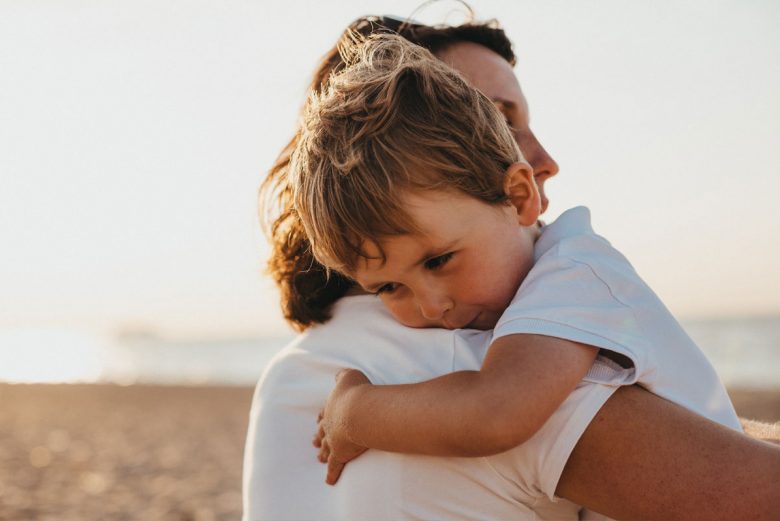
Even if nothing you say reassures your child, there’s still something you can do.
When a child’s fears get out of hand, it can feel exhausting—for both parents and child. Fortunately, it’s not your job to reassure a child until they feel better. Some simple solutions can help your child feel capable, too.
Carol and Anne share insights to break the fight-or-flight response and empower your child to get back to feeling safe again.
This week’s Parenting Practice
Practice the tips from this week’s episode by getting out a copy of The Child Whisperer book. Go to your child’s Type section, find the developmental stage section for 3-6 years, and read the phrases your child needs to hear. Write them down and use them daily.
Pair your efforts with the calming technique referenced in the podcast: Treating Children With Anxiety.
Transcript of podcast episode
Anne: There was a picture. We were at the doctor’s office, a really big wave, and she’s like, “What is that?” And I said, “It’s a tsunami and it’s coming to get you.” And she was like, “Oh…” And I’m like, “Okay, sorry that wasn’t very good.”
Carol: That’s when you need to call me and I’ll take you through this process I’m about to share.
Welcome to the Child Whisperer podcast, I’m your host, Carol Tuttle author of the bestselling parenting book, The Child Whisperer. I’m with my co-host Anne Tuttle Brown. I’m sure as a parent you’ve dealt with this with at least one of your children. The experience of dealing with what you’re perceiving in their world as unreasonable fears. I know you have, Anne.
Anne: I have.
Carol: You just went through a phase recently that you had this, and share what these fears can look like that we’re classifying as unreasonable.
Anne: Yes, and these are coming from my Type 3 6-year-old daughter. And, I mean they’re not unreasonable because they would be scary, but in her situation day-to-day life, like how frequently it was coming up was unreasonable in my mind. A lot of natural disasters, so very scared of fires, tornadoes, earthquakes, volcanoes. We live in Utah, but she’s frightened of volcanoes. I’m like, okay, well one’s not coming to get you.”
Carol: That’s unreasonable, but with her, in her world where she doesn’t understand that kind of bigger picture and scheme of things, that she can’t relate then.
Anne: Even dogs sometimes. Like monsters and things, not so much. But it’s, like, she…
Carol: But some children can have…That’s a challenge for many parents that I’ve heard from over the years is, “My child won’t go to bed in their own bed because they’re afraid.” What are they afraid of? They’re not even quite sure.
Anne: Yeah, and this would come up a lot at bedtime, and so I was, like, okay rolling my eyes, “Are you just trying to get out of going to bed and you want me here longer? Because you want me to, like, have sympathy and ‘oh, it’s okay,’ and reassure you or are you just using this tactic because you know mom’s going to stick around or are you really afraid of this?” I mean, it was a good year, six months to a year where this was just coming up and it would switch from fires to volcanoes to earthquakes.
Carol: On a daily experience?
Anne: I mean, at least couple of times a week, and then some weeks…
Carol: Would it always be around bedtime?
Anne: Yeah or just, like, during a conversation she would, like, just bring it out of the blue like, “I am never going to the big island of Hawaii because they still have a volcano. We traveled to Hawaii a lot, we have a home over there, so she’s been there a lot but she is, like, never going to the big island.
Carol: Well, let’s kind of break this down a bit. So first to consider in this categorically you would have to…Is it an unreasonable fear? What you’re mentioning is unreasonable, so I guess you could qualify it by the fact what are the percentages of this happening? I go swimming in the ocean in Hawaii and you know, the chances of me getting attacked by a shark are very, very small. But I know there’s been shark attacks literally right back in the waters behind our house within the last year, so that, like, bumped.
Anne: I guess we all have unreasonable fears in some people’s mind.
Carol: That took my percentages down for me because I’m, like, they took care of that percentage. So you first have to determine that is this unreasonable based on…What are the chances of this happening?
Anne: Not even unreasonable, but more just, like, annoying how often it was coming up and being distracting from just living her life, or like doing what I’ve asked her to do or you know, it just felt like it was getting in the way of things, and it was becoming inconvenient for her as well as me and it’s like, “Hey, look around and you’re going to be fine.” But, like, in her mind, it was so present.
Carol: Well, that’s kind of the next step. Whether you put it in the unreasonable category or not, they have not. And so, the classic parent strategy to deal with this is through reason. Through “If I can just talk to them, help them change their minds, help them see this differently, change their perception, we can shift and they’ll no longer have this fear.” You attempted that, right?
Anne: Uh-huh, I’ve tried to…well we live in Utah and there’s no such thing as volcanoes. Well if I…
Carol: How about lava?
Anne: Well, lava is really slow, you could run away from it. And she would always have a counter arg—
Carol: Did that help?
Anne: I mean in the moment, no, but I think overall helping her learn about these things. I mean, we have checked out volcano books from the library. I got a weather that talked about all sorts of things. We’d watch YouTube videos, you know. So I think in the long run, and I actually asked her the other day, I said, “How do you get over these fears?” Because it’s lessened, maybe getting older has helped too. She’s six and a half now. She said learning more about them has helped. But then she also followed up by, “But I’m still never going to the big island of Hawaii.” In the moment no because she was scared, her emotions are heightened.
Carol: Your nervous system triggers a emotional and mental response of being in that fight and flight. There are times we, people that have states of claustrophobia. Or I’ve done a lot of YouTube videos on anxiety, how to clear that. You know, kind of in the…even as an adult, you’re able to say, “This is unreasonable but I’m still feeling it.” Now when you’re young, when you’re 5 and having that, you don’t have the benefit of your adult world view and understanding to go, “What I’m feeling is unreasonable.” So you’re going to be…they’re kind of held captive to it.
In The Child Whisperer, I do teach and there is a phase of development between 3 to 6 years old where children are starting to feel a sense of independence. They start to disconnect just sort of emotionally and energetically for mom and dad and create a network outside the family. That’s the first phase of that.
Anne: We teach this in The Child Whisperer book what each phase of, like, there’s age grouping, 0 to 6 months, 6 to 18 months.
Carol: Yeah between birth and age 18, they’re focused on emotional development, and between 3 to 6, a child’s developmental focus is really learning about their own independence, the power.
Anne: Coming into their own power, yeah.
Carol: Yeah, in the world. And so, if you look at…I think most parents would say this is where it’s showing up in that age span so, that gives you an advantage right there to say maybe this has nothing to do with their fear. Their fear is really about feeling a sense of more independence and not quite sure, confident enough to navigate that to say, “I’ve got to create…” Subconsciously they’re creating some scenario to say, “I still need mommy and daddy. I’m scared.” And that could be provoking some of that.
Anne: Yeah, because these fears would make them feel very powerless and they’re kind of searching for their own power and figuring theirself out in this world and where they belong. So I think that gives me a lot of reassurance to be like, “Okay, this is just a normal process and we’ll just move through this and give you the support that you need.
Carol: To reinforce, I have phrases in the book to say to a child to help them be reinforced in this phase, you know, “I support you and that you can be safe in this world, that you have the ability to make choices that will keep you safe. You’ll know how to use your power.” Those aren’t the exact phrases but I give you the statements to now, just on a day-to-day basis, help them with that developmental experience so that they’re going, “I’m a powerful person that can make choices that keep me safe in this world.
One of Katie’s happens to be never going to the big island of Hawaii apparently, but that reinforces that they have a choice, they have power and with that, they can create outcomes they can depend on and that…because once they’re in that phase they’re in of unreasonable fear, they’re feeling powerless, as you said. So you want to just in your day-to-day practice of parenting a child in that age group, is learn what’s in The Child Whisperer, those phrases so you can reinforce that they are growing up as a confident, powerful human being that can be safe in this world.
Anne: Like you said, when you’re experiencing these fears and you’re in a fight or flight part of your brain, you’re not in, like, a reasonable state…
Carol: Yeah, you’re feeling that anxiety.
Anne: That’s why talking it out doesn’t work in the moment.
Carol: No.
Anne: So what are some tips to help that child kind of move through that emotion a little bit faster?
Carol: Well, I love that you asked me because you know what they are because I used them with you as a child.
Anne: Share with our listeners.
Carol: Anne grew up with a mother that did a lot of what might have appeared to others as that’s really different. That’s kind of out there. Yeah, when you’ve triggered these emotional states in a state of some degree of anxiety, reason doesn’t typically work to help create a state of calm.
Anne: Neither does teasing. I’ve tried that one.
Carol: You’ve tried teasing? Rolling your eyes.
Anne: Eye rolling. Yeah and totally frustrated a bit.
Carol: You want to throw some fuel on the fire do all of that.
Anne: I had this bad moment, but I was chuckling to myself. There was a picture, we were at the doctor’s office, really big wave, and she’s like, “What is that?” And I said, “It’s a tsunami and it’s coming to get you.” And she was like, “Oh…” And I’m like, “Okay, sorry that wasn’t very good.”
Carol: That’s when you need to call me and I’ll take you through this process I’m about to share. You are my child still. And I’m, like, my child, fight and flight, now she’s in fight mode.
Anne: Yeah, that’s true. She’s in flight and I’m in fight and it’s interesting, I never thought about that because I’m like, “Just get over it.”
Carol: You’re on the fight side of it. So here’s the technique and I teach you this in a YouTube video that we’ve included a link to in the copy on The Child Whisperer website where this is posted. It is an eye movement process.
Anne: The YouTube video is called “Treating Children with Anxiety”, if you want to Google it.
Carol: Yes. And it comes from my very early training in energy healing to help create states of calm. Your eyes are very connected to your brain and your brain is in charge of your emotional response, and also prompts your nervous system. And so, when you do a back and forth motion with your eyes, and I teach you how to do it on the YouTube video, just looking from right in your peripheral vision as far as you can, and you actually can just hold your finger up, or a pencil or something that’s an eye catching device, anything that they can look at, and you have them look from one side to the other, “Look over here, look over here, look over here. Take a deep breath, look over here.” And at some point, their eyes will flutter and they’ll break state. They will break that fight and flight state. The emotion will break and they’ll be able to come to a state of calm. Take a deep breath, relax. Now, ground that. Just walk around the room, just say you’re feeling better. Okay, well we’re here to make sure you’re safe.
Anne: Use some of those phrases.
Carol: Use those phrases, then reinforce it and you’re usually able to move on then pretty quickly from that.
Anne: I would say it too and then they try and bring it up again. I know that this has been a tactic that my daughter’s used to, like, distract at bedtime, keep me in her room a little bit longer.
Carol: That’s when they know. Can you tell the difference?
Anne: Yes, and I like this process because it’s going to help you move through it a little bit faster and also at that moment, I can just say, “Use some of those phrases, you’re safe, you have your power…I love you. Goodnight.” If she’s in her room crying, I’m just going to move on because at that point, I’m just like, you’re just like tired. And there have been times too where I’m like, “Let’s just not even talk about this, and get some food in your body, or just go to bed or drink of water. Let’s move through this.”
Carol: It’s really something else, you can tell when it’s a calculated effort too from a child. You can see it in their eyes actually because they’re eyes are looking like, “I’m remembering what to say that helps me out right now to delay this bedtime thing.” And yet, when it is a real fear-based response, you’re going to see it’s more full body. So it’s a very different inherent body language going on and they’re emoting when it’s a true fear versus the more calculated effort. This works.
Anne: Intellectual process.
Carol: You can start to intuitively read that. One thing I love about The Child Whisperer is I really help you learn an intuitive approach to parenting to read the scene, you know, to go, “Where’s this coming from?” You know, “What do I need to know right now?” This week’s parenting practice is to get a copy of The Child Whisperer, which I think most of you own already. If you don’t, go to thechildwhisperer.com and you’ll find it there. In the book, go to your child’s Type section, and find the three to six developmental stage section, and read the phrases your children need to be hearing.
So you can start to use those, not just in these moments where things are more intense, use them as a daily practice. Write them down. Make them familiar to yourself. Try one a day and then in the moment of that state of anxiety, use the technique that I’ve just taught you, the eye movement release process that allows you to help your child get into a calmer emotional state. You can go to the YouTube video and watch me demonstrate it. These two things will help you shift out of that mode of your child caught in this experience of unreasonable fears, which then gets to a point. I mean, Anne, your story, you dealt with this for quite a long time. A year?
Anne: Yeah.
Carol: And she’s grown out of it.
Anne: Uh-huh.
Carol: So you want to support your children too so that they learn these strategies, both thinking strategies and how to work with their own emotional state so they grow up into their adult years to know they’re not a victim to their own kind of flawed thinking and emotional upsets. They have an ability to shift things, to work with these tools so that they’re beneficiary to them, rather than feeling captive to them.
Many adults that I’ve worked with over the decades have come to me because they don’t have these tools, and you were raised with these tools, Anne. You’re now bringing this to the next generation and helping your children know you have a choice. You don’t have to fall prey to your kind of thinking that’s not supportive to you or emotional states that tick you out. You can make changes.
Thanks for listening. For more support, go to thechildwhisperer.com where you can purchase the book, subscribe to our weekly parenting practice email, and find a transcription in audio of “The Child Whisperer” podcast.
Anne: If you’re listening on iTunes, thank you for leaving your review. If you have a parenting question, please send it to [email protected].



